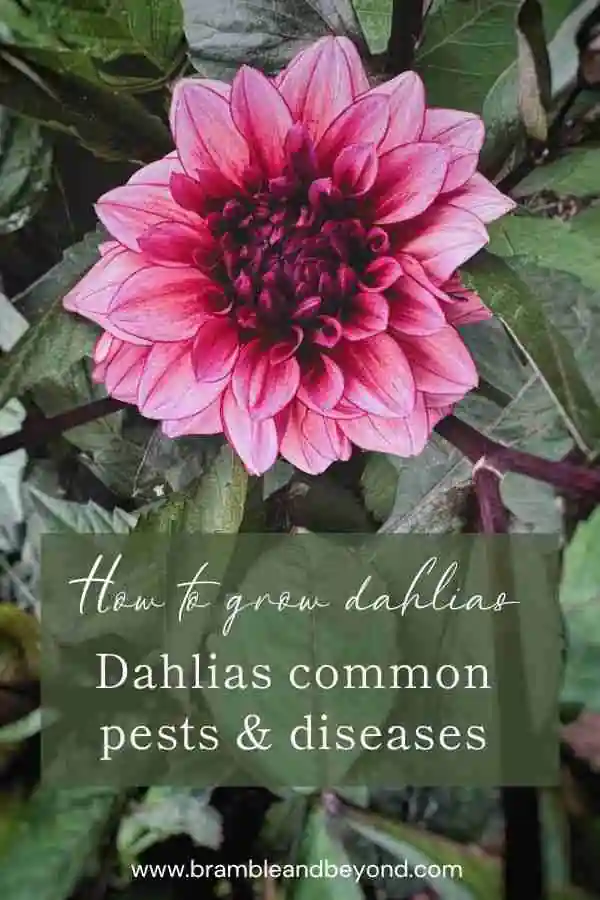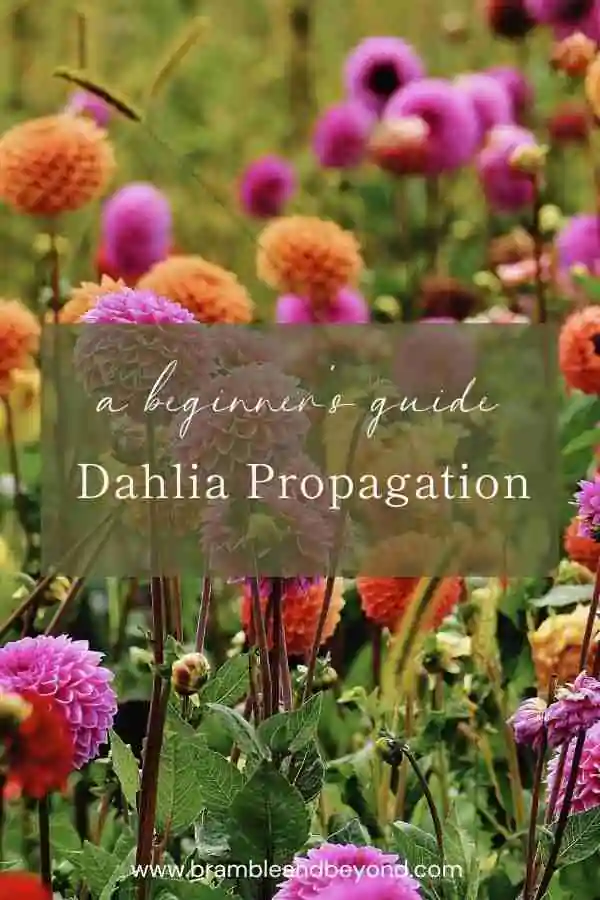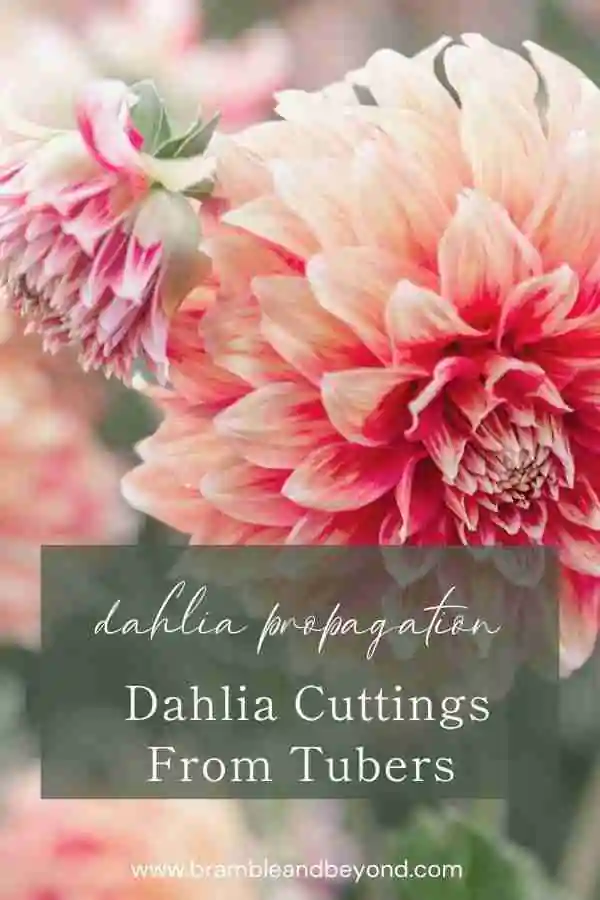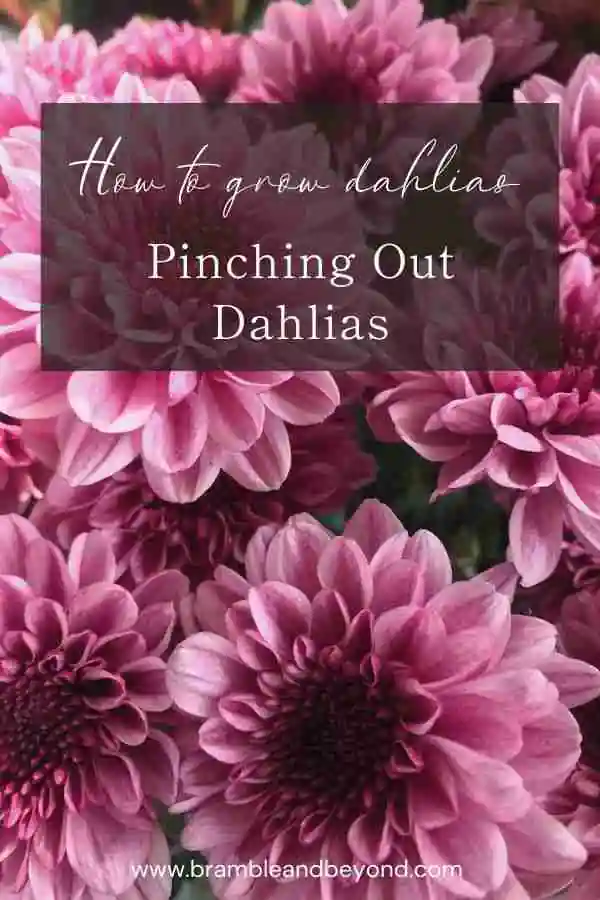Disclosure: This post may contain affiliate links, meaning I get commission if you decide to make a purchase through my links, at no cost to you. Please read my Affiliate Disclosure for more information.
Dahlias are a favourite among flower gardeners for their diverse flower colour, shapes and sizes. However, these beautiful plants can fall victim to a range of pests and diseases. 2024 has been a nightmare for many dahlia growers in the UK, with the persistent cool wet weather it has brought with it an enormous dahlia pest problem. For environmentally conscious gardeners, finding sustainable ways to protect dahlias is essential.
In general, if you want to protect a dahlia plant, the answer is consistent use of eco-friendly methods such as neem oil, insecticidal soaps, and companion planting to manage pests and diseases. Additional regular inspections of your plants, maintain healthy soil, and attract beneficial insects all help to keep your dahlias thriving.
The above is fine in theory, but the reality is much more complex when you see your dahlias whither overnight. In this guide, we’ll explore how to identify and manage the most common dahlia pests and diseases using eco-friendly solutions. From natural pest repellents to organic disease control, you’ll learn how to keep your dahlia garden healthy and thriving without resorting to harmful chemicals.
Identifying common dahlia pests and diseases
Alright, let’s get down to the nitty-gritty of dahlia pests and diseases. Here’s the cast of characters causing havoc in our gardens and how we can deal with them sustainably.
Common dahlia pests
Slugs and snails
Slugs and snails are the party crashers of the garden world, leaving irregular holes in your dahlia leaves and flowers. If you’ve ever gone out in the morning to find your dahlias looking like Swiss cheese, you’ve likely had a visit from these slimy intruders.
Slugs have been my biggest nuisance this year (and by nuisance I mean an all out war has been waged!). This year, it’s not just a case of a swiss cheese plant, its more a case of leaving behind just a carcass of a plant.
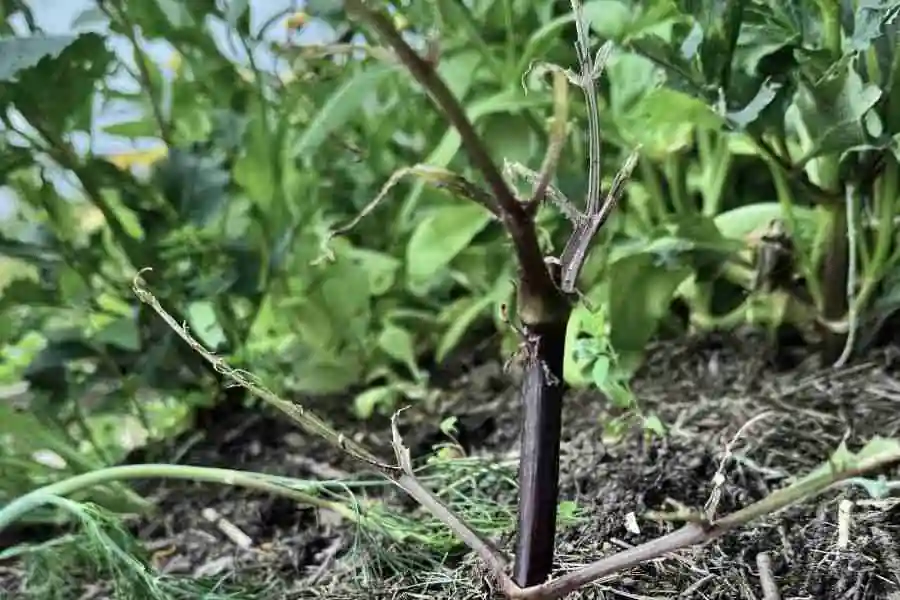
I have tried many control methods, none of which work 100% of the time. I cover my preferred slug and snail control methods in this post. The following is probably the most effective that I have found.
- Beer Traps: I swear, slugs are like little lushes. Bury a shallow dish filled with beer at soil level. The slugs will be drawn to the beer, fall in, and drown. It’s a bit morbid, but effective. Apparently substituting beer with coke, also works, but I haven’t tried this yet.
- Strulch Mulch: This is now my go to slug deterrent. Strulch is an effective weed suppressant, slug deterrent and water conserver all rolled into one. What’s not to love.
With time, and by following good gardening practices to improve the health of my soil, my garden might eventually be able to self-regulate when it comes to slugs, allowing us all to coexist peacefully. For now, though, the methods mentioned above help me keep the problem manageable.
Earwigs
Earwigs are those creepy-looking insects that also chew holes in dahlia petals and leaves. They’re nocturnal and can cause quite a bit of damage before you even realise they’re there. If you see holes in your petals then it has likely come from earwigs.
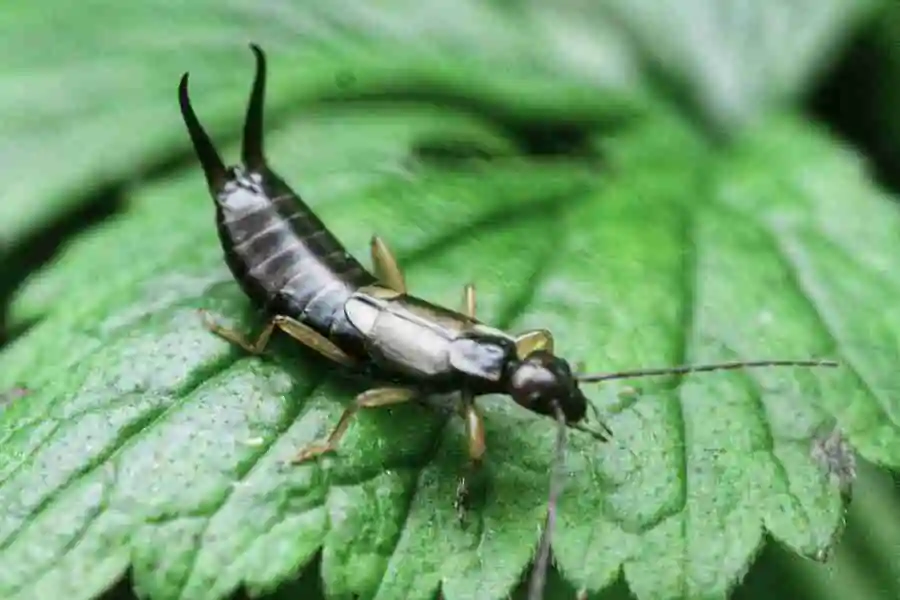
The common eco-friendly way of dealing with earwigs is to put an upturned pot filled with some straw on the top of a pole in your dahlia bed. The earwigs shelter in the straw and you can tip them out somewhere else. You can also do something similar with newspaper traps. Where you roll up damp newspaper and place it around your garden. Earwigs will crawl in, and you can dispose of the paper (and the bugs) in the morning.
However, you can often avoid this by choosing your dahlia variety thoughtfully. Some dahlias are more likely to attract earwigs than others. The big decorative dahlias, with their layers of petals, provide great hiding spots for earwigs, making them more likely to be affected.
On the other hand, the simpler single and collerette dahlias don’t offer as much cover. So, if you really want to avoid earwigs, it’s best to skip growing the big decorative dahlias. But that would be such a shame.
Earwigs may be a pest on dahlias, but they are otherwise an asset in the garden. They feed heavily on aphids, blackfly and greenfly so it’s more important to create a good eco system, rather than trying to eliminate all pests.
I’m keeping my fingers crossed as I say this, but I’ve never really had much trouble with earwigs, even though I know they’re in the garden. Sure, there have been a few nibbles here and there, but nothing that harms the dahlias or that I can’t handle.
Spider mites
Spider mites are tiny arachnids that suck the life out of your dahlia leaves, leaving them yellow and stippled. If you see fine webbing on your plants, you’ve likely got spider mites.

To avoid or remove spider mites, try one of the following techniques:
- Regular Watering and Misting: Spider mites thrive in dry conditions, so keep your plants well-watered and mist them regularly to increase humidity.
- Neem Oil: Mix neem oil with water and spray it directly onto the affected areas. Neem oil disrupts the mites’ lifecycle.
- Ladybirds: Release ladybirds in your garden. They love munching on spider mites. In fact, always do whatever you can to attract ladybirds as they fend off a whole host of pests throughout the garden.
Thrips
Thrips are tiny and tricky to spot, but they are slender insects with fringed wings. These little critters, much like spider mites, can cause some discolouration and distortion to your leaves and blossoms. If left unchecked, they might weaken your entire plant. Plus, thrips can carry bacteria and viruses from one plant to another, so are best avoided.
Here are some eco approaches you could use to deal with thrips:
- Consistent Watering: Plants stressed by heat and drought are particularly susceptible to thrips. Keeping your dahlias consistently watered can help discourage them.
- Insecticidal Soaps: These can temporarily reduce an outbreak. Dilute the soap with water as directed and spray directly onto the pests, ensuring to cover all affected areas.
- Natural Predators: Introduce natural predators like lacewings and predatory mites to your garden. These beneficial insects can help keep thrips populations in check. I have found that wasps are also a good predator to thrips, so they also have their uses.
Common dahlia diseases
Crown/Leafy gall
Crown or leafy gall is caused by the bacterium Agrobacterium tumefaciens and shows up slightly differently in the plants but the effect is the same. Initially, the plants will grow and flower fine, so they might not appear to have a problem, but don’t be fooled. Eventually, it can stunt plant growth and kill the plant if left unchecked. It is also easily spread, so care is needed.
Crown gall shows as round bulbous growths with no sprouts on the roots of dahlias. This is difficult to spot, as dahlias grow from tubers. However, in general, the growths are more rounded and discoloured compared to the rest of the tubers.
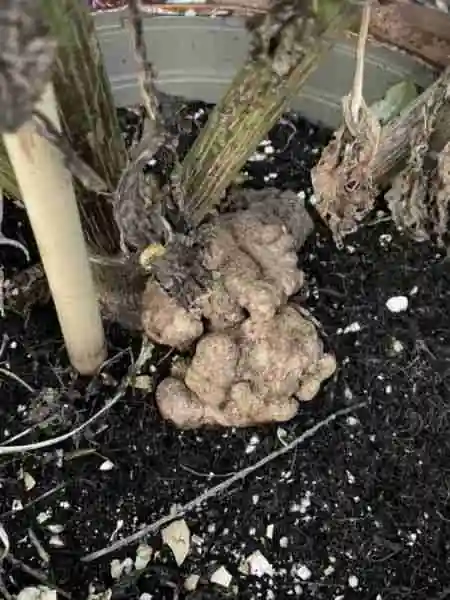

Leafy gall is easier to spot as you will see fused buds on the tuber that look like the head of a cauliflower. These will not have a clear growing tip and again are often discoloured. Tubers can, of course, grow multiple healthy buds on a tuber, and as long as they are not fused together, then they are fine.
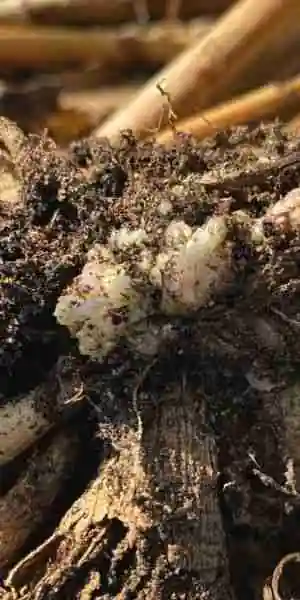
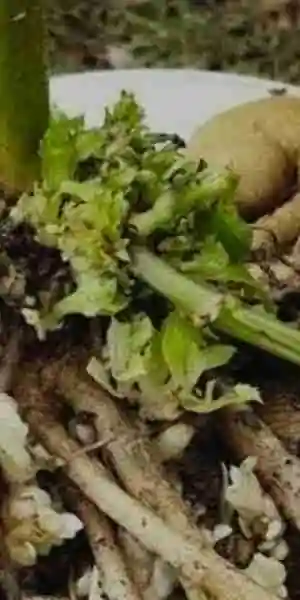
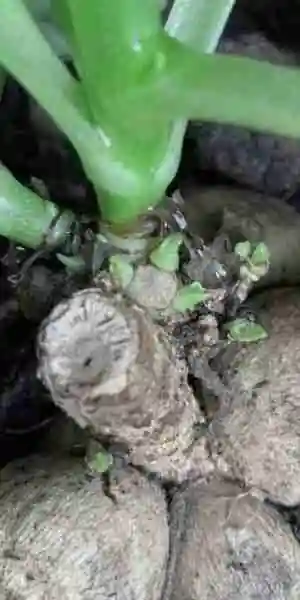
Gall seems to be becoming much more prevalent than it ever was, possibly due to the rise in the popularity of dahlias, or maybe just misdiagnosis. With the majority of our plants coming from the same Dutch suppliers, it is not surprising that this contagious disease is spreading enormously.
Here is a video showing how I found leafy gall in some of my dahlia tubers:
Dahlia mosaic virus
Dahlia mosaic virus causes mottled leaves and stunted growth. Unfortunately, once a plant is infected, there’s no cure. It is however, difficult to recognise, as it could simply be a nutrition deficiency.
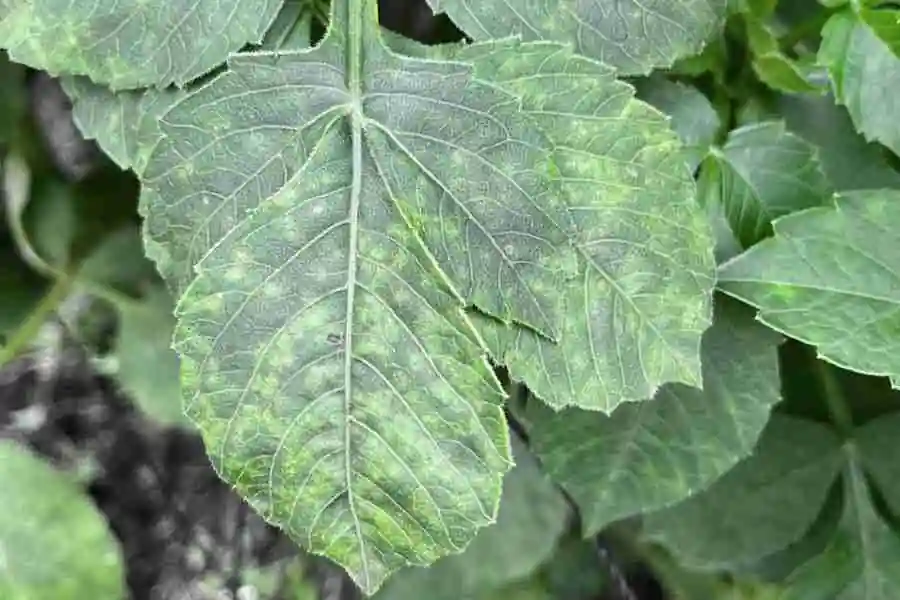
When you spot the above affect on your dahlia leaves, firstly give it a feed of epsom salts (use a teaspoon in a watering can) and see if it improves. If it doesn’t then the only option is to remove and destroy any infected plants to prevent the virus from spreading.
Powdery mildew
Powdery mildew is a fungal infection that looks like someone sprinkled flour on your dahlia leaves. It loves warm, humid conditions and usually appears in the second half of the growing season. While powdery mildew can make plants weaker, it’s mostly a cosmetic issue. To keep it in check, make sure to space your plants well to improve air circulation and reduce humidity.
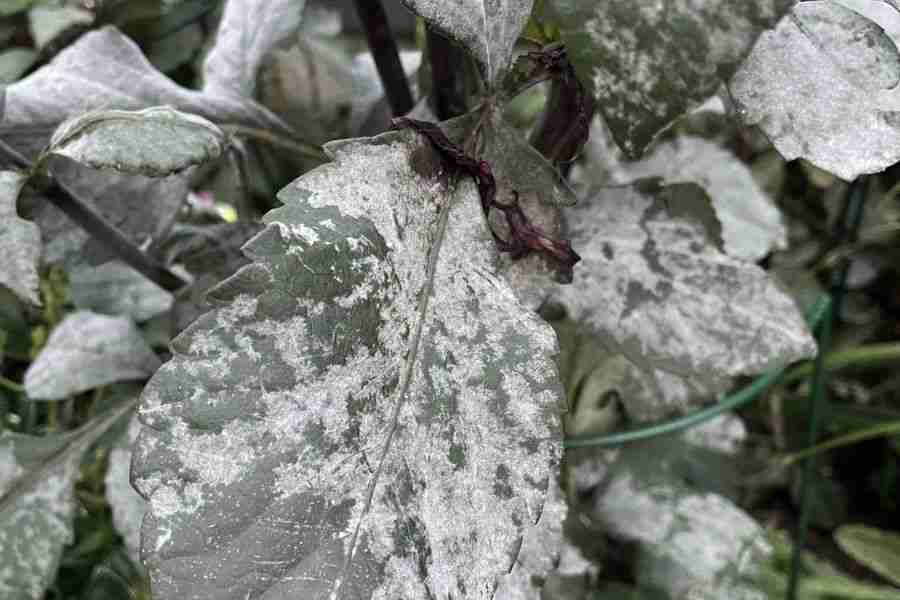
If you live in an area where mildew is a common problem, you might just have to accept the damage. However, powdery mildew can be managed with an anti-fungal spray, but you’ll need to start applying it before the disease shows up and keep using it throughout the growing season.
Organic methods to control dahlia pests and diseases
Healthy plants are less susceptible to diseases and a healthy garden ecosystem, following good gardening practices, is your best defence against pests and diseases in the long run.
Here’s how to keep your dahlias strong and disease-free.
Prevent overwatering
Overwatering can lead to fungal infections and root rot. It is much better for plants to develop strong healthy roots and find their own water than watering them too much.
Try these tips to help prevent overwatering:
- Water early: Water your dahlias early in the day to allow moisture to evaporate before nightfall.
- Well-draining soil: Ensure your soil is well-draining to prevent water from pooling around the roots.
- Water at the base: Avoid watering the foliage. Instead, water at the base of the plants.
Attract beneficial insects
Beneficial insects, such as ladybirds, lacewings, and parasitic wasps, play a crucial role in natural pest control not only for dahlias but for your garden as a whole. Here’s some ideas on how to attract them:
- Plant diversity: Plant a wide variety of flowers that provide nectar and pollen, such as yarrow, fennel, and dill, to name a few.
- Avoid chemical pesticides: These can harm beneficial insect populations.
Maintain good soil health
Healthy soil is the foundation of a thriving garden. Improving the structure of the soil, results in better retention of nutrients, less weeds and better water retention. All of this can be achieved using the following methods, and will only improve the longer you persevere:
- Composting: Add organic matter to improve soil fertility and structure.
- Mulching: Helps retain moisture and suppress weeds.
- Crop Rotation: Prevents the buildup of pathogens and pests in the soil.
- No dig gardening: No dig gardening not only enhances the soil structure and fosters beneficial microorganisms, but also creates an optimal environment for plant growth.
Maintain a tidy garden
Keeping your garden tidy and well-maintained will help prevent the creation of spaces where the pests we mentioned earlier can make a home, reproduce, and multiply. By regularly trimming, weeding, and cleaning up debris, you can create an environment that is less attractive to these unwanted visitors. Additionally, removing standing water and ensuring proper drainage can further discourage pests from settling in your garden.
Protecting your dahlias from pests and diseases doesn’t mean you have to compromise your commitment to the environment. By using eco-friendly solutions and fostering a healthy garden ecosystem, you can enjoy beautiful, thriving dahlias without the need for harmful chemicals. Remember, the key to successful gardening lies in prevention and early intervention. With these tips and methods, even beginner gardeners can manage common dahlia pests and diseases sustainably.
As gardener and environmentalist Lady Bird Johnson once said, “Where flowers bloom, so does hope.” By nurturing our gardens with care and respect for the environment, we not only create beauty but also contribute to the health of our planet.
Happy gardening!
Tips for growing your dahlias
- Divide your dahlias: To produce good sized productive dahlia plants, it is a good idea to divide the tuber every few years. If the tuber is too large, then you get increasing amount of foliage and poorer quality blooms.
- Starting your dahlias: From March onwards you can start your dahlias tubers growing in pots in a protected growing space. The space doesn’t need to be heated, but it does need to have light and be protected from frost.
- Propagate your dahlias: Once your potted up dahlias start producing more than 5 new shoots you can take cuttings of any of the extra cuttings, to create new plants that will flower and create a tuber within this growing season.
- Pinch out shoots: Once you have stems that have a few sets of leaves, then pinch out the growing tip. This will encourage the plant to produce more lateral growth and flowering stems.
- Planting: When planting your dahlias, plant out the plants deep enough to cover the tuber. Place the tubers about 15cm (6 inches) deep. Space the tubers/plants about 40cm – 70cm apart. Only plant out once the risk of frost has passed. In the UK this is generally mid May.
- Watering: After planting, water them in well. After the initial watering, I prefer to water all my plants (if I need to water) with a long deep drink, rather than a light consistent watering. I think this encourages the plants to go in search of their own water, making them more drought tolerant.
- Provide support: Dahlias, especially tall varieties, will need staking or other support to prevent them from toppling over under the weight of their blooms. It is best to get this in place before you need it, rather than waiting until it is too late.
- Protect from pests: Avoid chemical pesticides in your dahlia bed. Instead, encourage beneficial insects, try companion planting, use physical barriers, or try homemade, eco-friendly sprays.
- Protect from frost: In the autumn, after the first frost, either cut back your dahlias and mulch heavily to protect the tubers over the winter. Or lift them and store them somewhere cool and dry overwinter.

